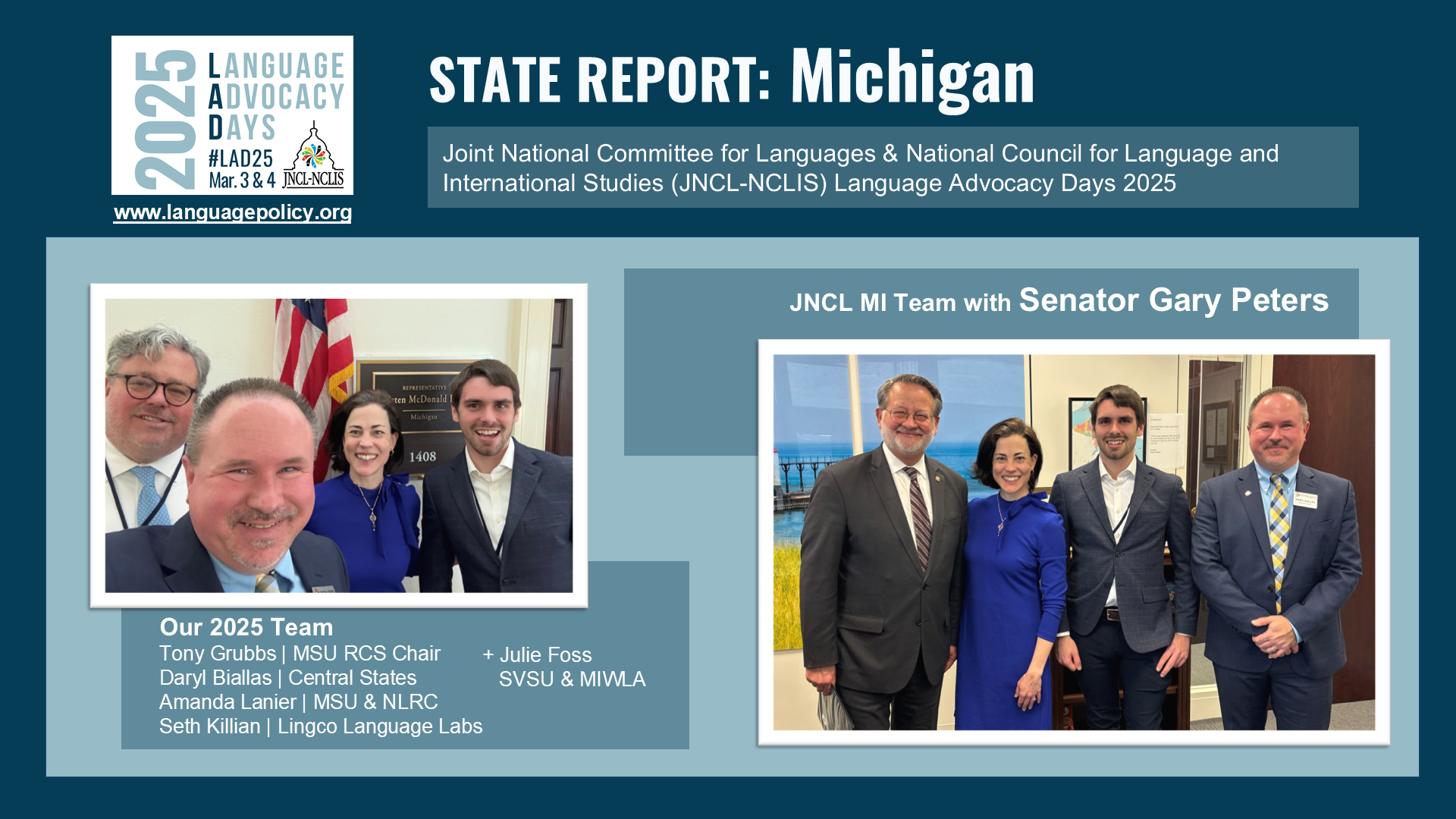According to the American Academy of Arts & Sciences Commission on Language Learning, the Joint National Committee for Languages, the U.S. Department of Education’s current International Strategy, and the American Council on the Teaching of Foreign Languages (ACTFL), as well as a variety of articles in the media, the field of world language teaching in the U.S. is facing a crisis. A very low percentage of K-16 students enroll in foreign languages; few of them reach high levels of proficiency; and most U.S. states report a shortage of foreign language teachers and a shortage of candidates to become language teachers.

As an Atlantic Monthly article recently claimed, “the country is falling behind the rest of the world” (Friedman, 2015). That statement was not limited to the widespread monolingualism in the U.S. lagging behind the multilingual or plurilingual competence that is the norm in most other countries; it encompassed economic competition and political power, as well. And learning to code is not an adequate replacement.
[This report’s] primary goal, therefore, is for every school in the nation to offer meaningful instruction in world languages as part of their standard curricula.
America’s Languages – Executive Summary
The advocacy efforts seem to be falling on deaf ears, though. Many U.S. Americans are very comfortable with the idea that the next generation will grow up just as monolingual in English as they are. I witnessed that in a very personal way just a few weeks ago, when I had the audacity to bring up this “crisis” in my own parents’ kitchen. My uncle, who has lived in Germany for 30 years, and his German wife, daughters, son-in-law, and grandson had just departed that morning after an extended visit.
“In crisis?” my parents responded. “How can that be a crisis? We don’t need to speak any language other than English in our day-to-day lives.”
And they are exactly right. They don’t need to speak any language other than English. My family happens to live in a particularly monolingual wedge of metropolitan Atlanta. They have frequent visitors from overseas, but the visitors are almost always bilingual. When they travel outside the U.S., which they have many times since I left the nest, their English is satisfactory for communication, or a tour guide translates for them. The fact that their daughter has lived overseas for four years, studied four languages, earned a PhD in applied linguistics, and worked with language teachers around the world is a matter of some pride for them, maybe, but the value of the subject and objectives of what I teach is mostly abstract to them.
Multilingualism is all well and good, but in their eyes, and the eyes of many other U.S. Americans, the lack of it is no crisis. They believe that other crises around the world, including armed conflict and threats to the environment, are more significant, and other subjects of study are more essential for career preparation. Like so many other adults in the U.S., they retained little from their own study of foreign languages, and their experience of language learning would lead them to believe that the process involves memorizing vocabulary, practicing conjugations, trying not to make any errors, and learning “cultural” facts that mostly relate to geography and history.
The rest of metropolitan Atlanta is far from monolingual, though, as is the region where I live now in mid-Michigan. Immigrant and transnational families (like those of many MSU graduate students) speak languages that are prominent around the globe and maintain strong connections with many other countries. Many Native American families are aware that their languages could be lost in a single generation if they do not pass on their languages.

You can find out which languages are spoken in your area and relative numbers of people who speak them by visiting the MLA Language Map.
These parents of heritage language learners, by which I mean children who have a cultural connection to a language other than English and may or may not be bilingual, would be utterly delighted and relieved to hear their children speak their native language. Ideally, they would like to give them the opportunity for instruction outside the home in a structured setting, with qualified teachers, without spending an inordinate amount of money. In other words, they would like public schools to offer more languages, more effectively. For them, the dearth of such opportunities and the shortage of qualified teachers outlined in the American Academy of Arts & Sciences report is most definitely a crisis.
The struggle, then, lies in convincing monolingual parents, as well as monolingual school administrators, university deans and provosts, and government officials, that they should pour effort into providing opportunities for the majority of their children to grow up multilingual. As I contended in my dissertation, which focused on investment in Arabic as a critical and heritage language, language learners and everyone around them who has an influence on their education have to make a very complex cost-benefit analysis as they decide where limited time, money, and other resources will go. Even if they agree on an intellectual level that developing proficiency in an additional language, or studying it at all, would enrich the student’s education, they may still see other subjects and other aspects of the children’s formation as more essential.
I wish I could say that my academic unit at MSU, the Center for Language Teaching Advancement, has advocated successfully for language learning at our own university, but college students are suddenly in the position of making that same cost-benefit analysis by themselves. They opt out of languages in favor of more obviously career-oriented subject areas. Mark Largent, the Associate Provost for Undergraduate Education, recently started driving around campus in the new Student Success Express (a cute electric vehicle called a Gem, apparently) as a way to get students to articulate their interests and concerns. He summed up his new insights as “one consistent theme”:
In their own way, most students talk about how they have trouble choosing from among the myriad of social and academic choices they confront every day. They talk about how they often feel overwhelmed by all the options available to them and anxious that they are not making the most of their time in college. (Largent, Oct. 31, 2019)
Convincing these parents and stakeholders and the learners themselves otherwise involves a complex and multi-pronged series of arguments and also the ability to follow up on those arguments with demonstrations that the field of foreign language teaching can deliver the promised benefits. Here is the sequence of assumptions that parents need to be able to make:
- If my child develops proficiency in an additional language, my child will succeed in life, i.e., be gainfully employed and happy.
- If my child has access to effective foreign language instruction at school, my child will develop proficiency.
- If my child’s school offers foreign language classes, that FL instruction will be high-quality, engaging, and effective.
- If I do not do something, my child’s school will not be able to offer foreign language classes.
They are presented here in an interlocking logical sequence, though that list still oversimplifies the issues. Also, that sequence can fall apart at any of its junctures. Going the other direction, though, we have our marching orders: schools should offer the FLs (which ones is another story), the FLs should be taught effectively, and the students should be reaching levels of proficiency that can have appreciable benefits for their future. At the same time, they can, and I would argue should, also be having experiences in their FL classes that enhance their lives and educational experiences in the present.
America’s Languages: Investing in Language Education for the 21st Century

Drivers of U.S. Policy Regarding Language Learning and Internationalization in Education
American Academy of Arts & Sciences Commission on Language Learning
Joint National Committee for Languages
Department of Education’s current International Strategy
American Council on the Teaching of Foreign Languages
Resources for Exploring Languages Spoken in the U.S.
Modern Language Association (MLA) Language Map





